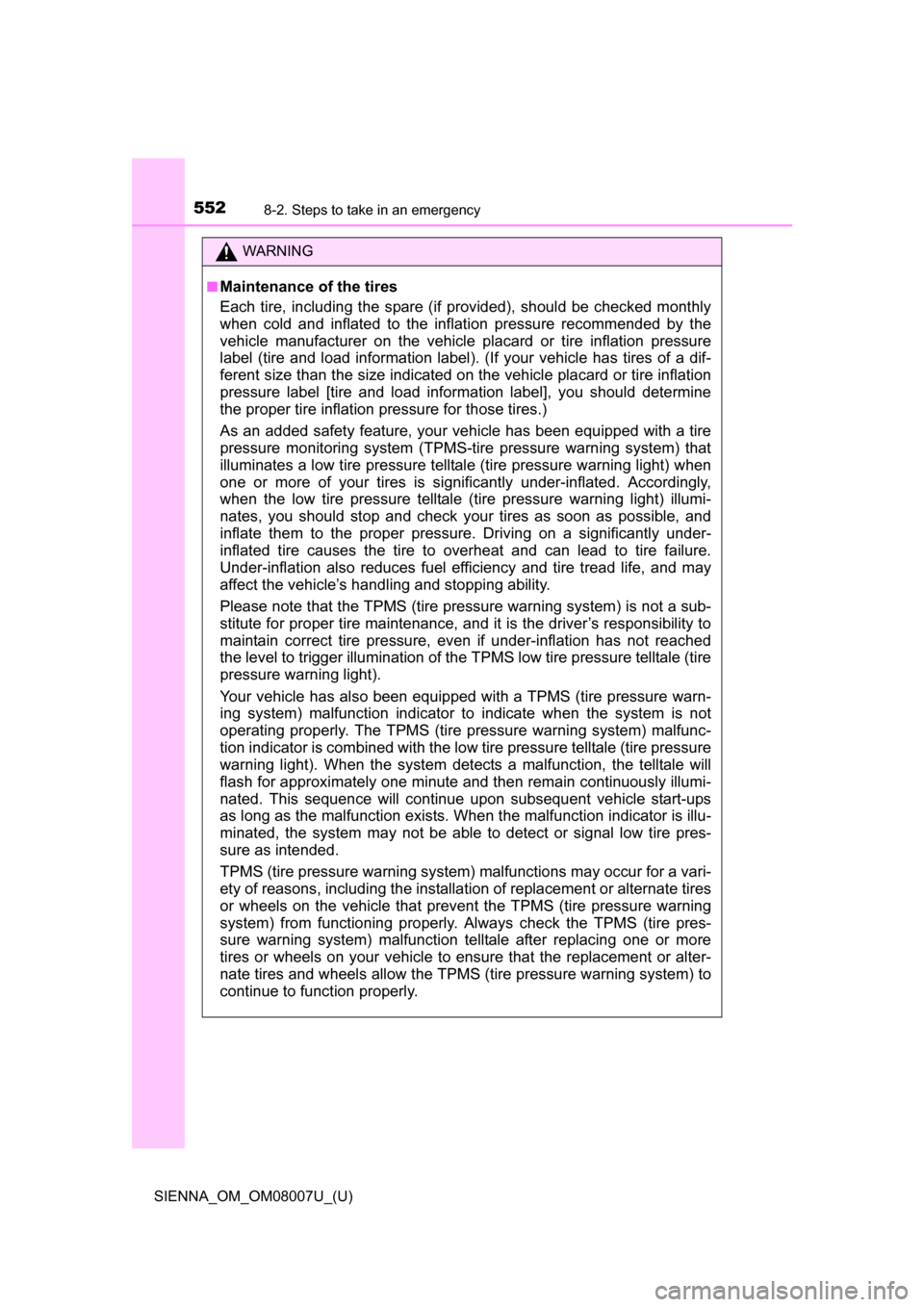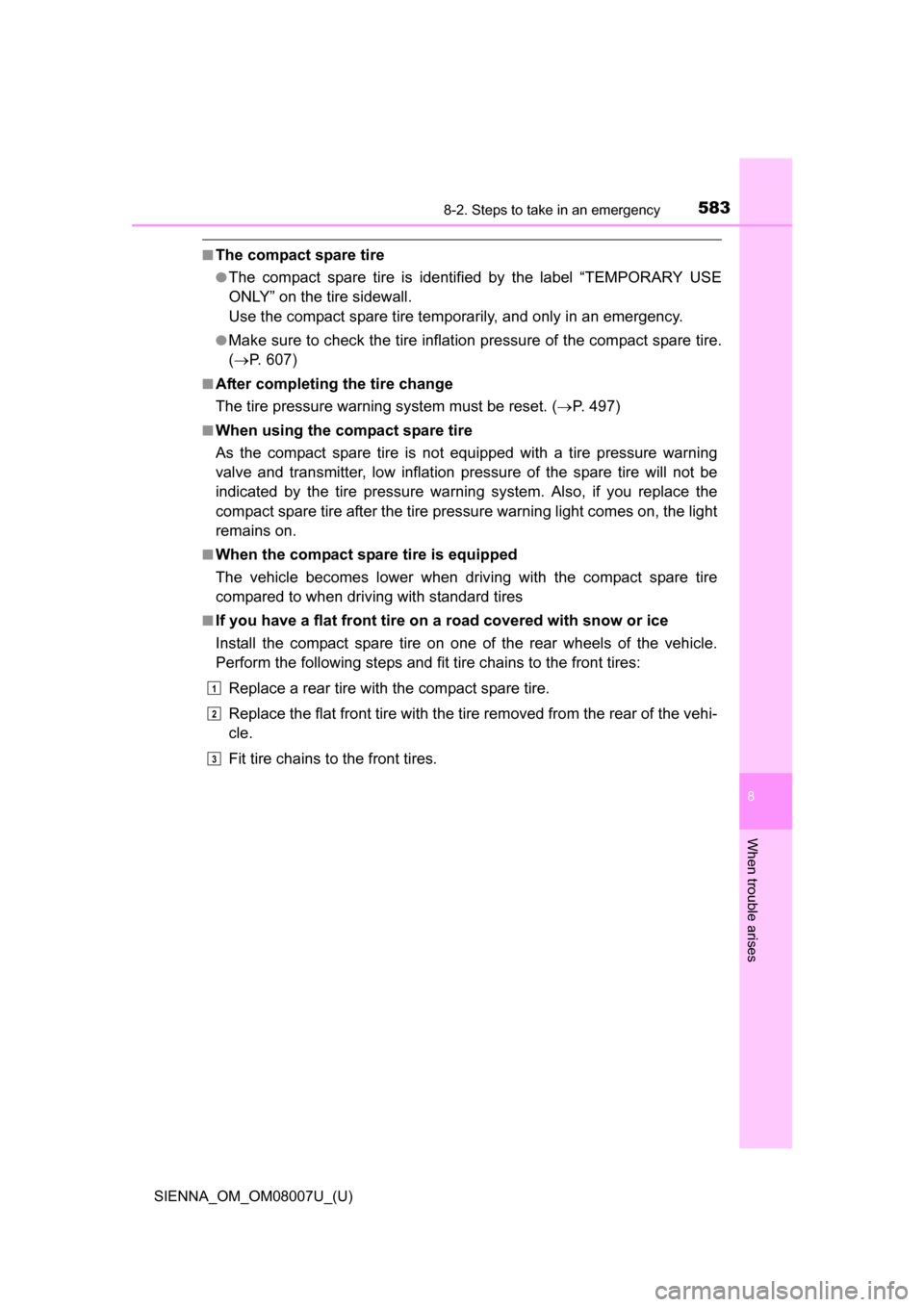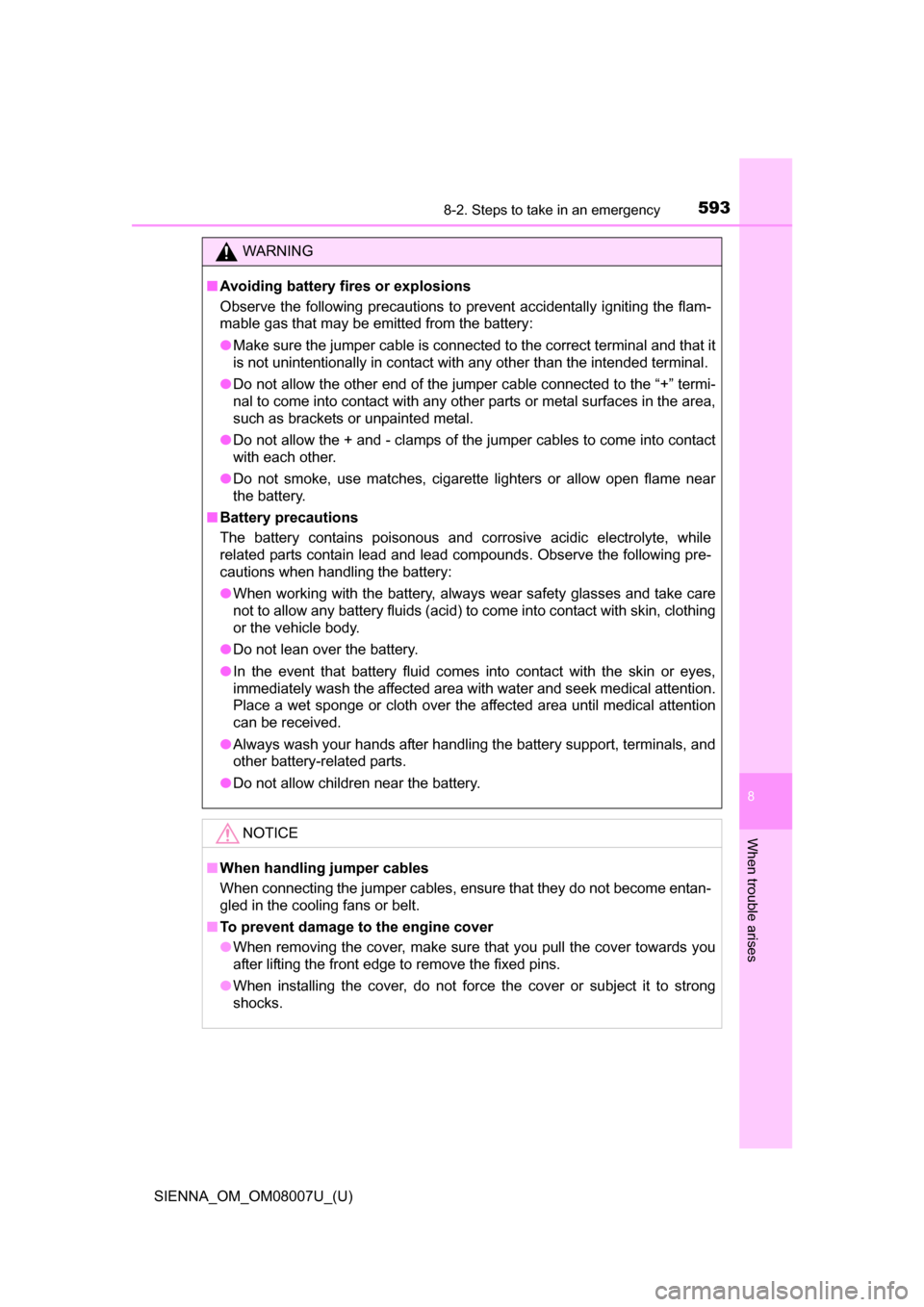Page 552 of 672

5528-2. Steps to take in an emergency
SIENNA_OM_OM08007U_(U)
WARNING
■Maintenance of the tires
Each tire, including the spare (if provided), should be checked monthly
when cold and inflated to the inflation pressure recommended by the
vehicle manufacturer on the vehicle placard or tire inflation pressure
label (tire and load information label). (If your vehicle has tires of a dif-
ferent size than the size indicated on the vehicle placard or tire inflation
pressure label [tire and load information label], you should determine
the proper tire inflation pressure for those tires.)
As an added safety feature, your vehicle has been equipped with a tire
pressure monitoring system (TPMS-ti re pressure warning system) that
illuminates a low tire pre ssure telltale (tire pressure warning light) when
one or more of your tires is significantly under-inflated. Accordingly,
when the low tire pressure telltale (tire pressure warning light) illumi-
nates, you should stop and check your tires as soon as possible, and
inflate them to the proper pressure. Driving on a significantly under-
inflated tire causes the tire to overheat and can lead to tire failure.
Under-inflation also reduces fuel effi ciency and tire tread life, and may
affect the vehicle’s hand ling and stopping ability.
Please note that the TPMS (tire pres sure warning system) is not a sub-
stitute for proper ti re maintenance, and it is the driver’s responsibility to
maintain correct tire pressure, even if under-inflation has not reached
the level to trigger illumina tion of the TPMS low tire pressure telltale (tire
pressure warning light).
Your vehicle has also been equipped with a TPMS (tire pressure warn-
ing system) malfunction indicator to indicate when the system is not
operating properly. The TPMS (tire pressure warning system) malfunc-
tion indicator is combined with the lo w tire pressure telltale (tire pressure
warning light). When the system dete cts a malfunction, the telltale will
flash for approximately one minute and then remain continuously illumi-
nated. This sequence will continue up on subsequent vehicle start-ups
as long as the malfunction exists. When the malfunction indicator is illu-
minated, the system may not be able to detect or signal low tire pres-
sure as intended.
TPMS (tire pressure warning system) malfunctions may occur for a vari-
ety of reasons, including the installati on of replacement or alternate tires
or wheels on the vehicle that prevent the TPMS (tire pressure warning
system) from functioning properly. Always check the TPMS (tire pres-
sure warning system) malfunction te lltale after replacing one or more
tires or wheels on your vehicle to ensure that the replacement or alter-
nate tires and wheels allow the TPMS (tire pressure warning system) to
continue to function properly.
Page 554 of 672
554
SIENNA_OM_OM08007U_(U)
8-2. Steps to take in an emergency
If a war ning message is displayed
Master warning light
The master warning light also comes on or flashes in order to indicate that
a message is currently being displayed on the multi-information display.
Multi-information display
If any of the warning message or indicator comes on again after the
following actions have been performed, contact your Toyota dealer.
If a warning message is shown on the multi-information display,
stay calm and perform the following actions:
1
2
Page 561 of 672

5618-2. Steps to take in an emergency
SIENNA_OM_OM08007U_(U)
8
When trouble arises
Indicates that engine oil level is lowThis message may appear if the vehicle is
stopped on a slope. Move the vehicle to a level
surface and check to see if the message disap-
pears.
A buzzer also sounds.
Check the level of engine oil, and add or
replace if necessary.
Indicates abnormal engine oil pressure A buzzer also sounds.
Immediately stop the vehicle in a safe place
and contact your Toyota dealer.
(AWD models)
Indicates a malfunction in the Active Torque
Control 4WD system A buzzer also sounds.
Have the vehicle inspected by your Toyota
dealer.
Vehicles without a smart key system:
Indicates that the engine switch is turned to the
“LOCK” position, the key is removed and the
driver’s door is opened while the lights are turned
on.
Vehicles with a smart key system:
Indicates that the engine switch is turned off and
the driver’s door is opened while the lights are
turned on. A buzzer also sounds.
Turn the lights off.
Warning messageDetails/Actions
(Flashes)
Page 566 of 672

5668-2. Steps to take in an emergency
SIENNA_OM_OM08007U_(U)
InteriorbuzzerExterior buzzerWarning messageDetails/Actions
Power was turned off due to the
automatic power off function.
Next time when starting
the engine, increase the
engine speed slightly and
maintain that level for
approximately 5 minutes
to recharge the battery.
Con-
tinu-
ous The driver’s door was opened
while any shift position other
than P was selected without
turning off the engine switch.
Shift the shift position to P.
Con-
tinu-
ousContin-
uous
The electronic key was carried
outside the vehicle and the
driver’s door was opened and
closed while any shift position
other than P was selected with-
out turning off the engine
switch.
Shift the shift position to P.
Bring the electronic key
back into the vehicle.
Once An attempt was made to start
the engine without the elec-
tronic key being present, or the
electronic key was not function-
ing normally.
Start the engine with the
electronic key present.
An attempt was made to drive
when the regular key was not
inside the vehicle.
Confirm that the elec-
tronic key is inside the
vehicle.
(Flashes)
(Displayed alternately)
(Flashes)
(Flashes)
Page 570 of 672
570
SIENNA_OM_OM08007U_(U)
8-2. Steps to take in an emergency
If you have a flat tire (vehicles with run-flat
tires)
Take your vehicle to the nearest
Toyota dealer or authorized tire
dealer as soon as possible if any
tire goes flat.
The vehicle can be driven for a
maximum of 100 miles (160 km)
at a speed below 50 mph
(80 km/h) after the tire pressure
warning light comes on.
( P. 547)
■In some condition (such as at high temperatures)
You cannot continue driving for up to 100 miles (160 km).
■For the detailed information on run-flat tires
See the tire warranty booklet.
Your vehicle is not equipped wi th a spare tire, but instead you
can continue driving the vehicle with run-flat tires even if any
tire goes flat.
In this case, slow down and drive with extra caution.
Run-flat tires (A “RFT” or “DSS T” mark is molded on the side-
wall)
Page 583 of 672

5838-2. Steps to take in an emergency
SIENNA_OM_OM08007U_(U)
8
When trouble arises
■The compact spare tire
●The compact spare tire is identified by the label “TEMPORARY USE
ONLY” on the tire sidewall.
Use the compact spare tire temporarily, and only in an emergency.
●Make sure to check the tire inflatio n pressure of the compact spare tire.
( P. 607)
■After completing the tire change
The tire pressure warning system must be reset. ( P. 497)
■When using the compact spare tire
As the compact spare tire is not equipped with a tire pressure warning
valve and transmitter, lo w inflation pressure of the spare tire will not be
indicated by the tire pressure warning system. Also, if you replace the
compact spare tire after the tire pressure warning light comes on, the light
remains on.
■When the compact spare tire is equipped
The vehicle becomes lower when driving with the compact spare tire
compared to when driving with standard tires
■If you have a flat front tire on a road covered with snow or ice
Install the compact spare tire on one of the rear wheels of the vehicle.
Perform the following steps and fit tire chains to the front tires:
Replace a rear tire with the compact spare tire.
Replace the flat front tire with the tire removed from the rear of the vehi-
cle.
Fit tire chains to the front tires.
1
2
3
Page 593 of 672

5938-2. Steps to take in an emergency
SIENNA_OM_OM08007U_(U)
8
When trouble arises
WARNING
■Avoiding battery fires or explosions
Observe the following precautions to prevent accidentally igniting the flam-
mable gas that may be emitted from the battery:
●Make sure the jumper cable is connected to the correct terminal and that it
is not unintentionally in contact with any other than the intended terminal.
● Do not allow the other end of the jumper cable connected to the “+” termi-
nal to come into contact with any other parts or metal surfaces in the area,
such as brackets or unpainted metal.
● Do not allow the + and - clamps of the jumper cables to come into contact
with each other.
● Do not smoke, use matches, cigarette lighters or allow open flame near
the battery.
■ Battery precautions
The battery contains poisonous and corrosive acidic electrolyte, while
related parts contain lead and lead compounds. Observe the following pre-
cautions when handling the battery:
●When working with the battery, always wear safety glasses and take care
not to allow any battery fluids (acid) to come into contact with skin, clothing
or the vehicle body.
● Do not lean over the battery.
● In the event that battery fluid comes into contact with the skin or eyes,
immediately wash the affected area with water and seek medical attention.
Place a wet sponge or cloth over the affected area until medical attention
can be received.
● Always wash your hands after handling the battery support, terminals, and
other battery-related parts.
● Do not allow children near the battery.
NOTICE
■When handling jumper cables
When connecting the jumper cables, ensure that they do not become entan-
gled in the cooling fans or belt.
■ To prevent damage to the engine cover
●When removing the cover, make sure that you pull the cover towards you
after lifting the front edge to remove the fixed pins.
● When installing the cover, do not force the cover or subject it to strong
shocks.
Page 653 of 672
653What to do if... (Troubleshooting)
SIENNA_OM_OM08007U_(U)
●The seat belt reminder light is flashing
Are the driver and the front passenger wearing the seat belts? (P. 547)
●The brake system warning light is on
Is the parking brake released? (P. 241)
Depending on the situation, other types of warning buzzer may also sound.
( P. 545, 554)
●Did anyone inside the vehicle open a door during setting the alarm?
The sensor detects it and the alarm sounds. ( P. 77)
To stop the alarm, turn the engine switch to the “ON” position (vehicles with-
out a smart key system) or IGNITION ON mode (vehicles with a smart key
system) or start the engine.
●Is the message displayed on the multi-information display?
Check the message on the multi-information display. ( P. 554)
A warning buzzer sounds during driving
An alarm is activated and the horn sounds (if equipped)
A warning buzzer sounds when leaving the vehicle
(vehicles with a smart key system)